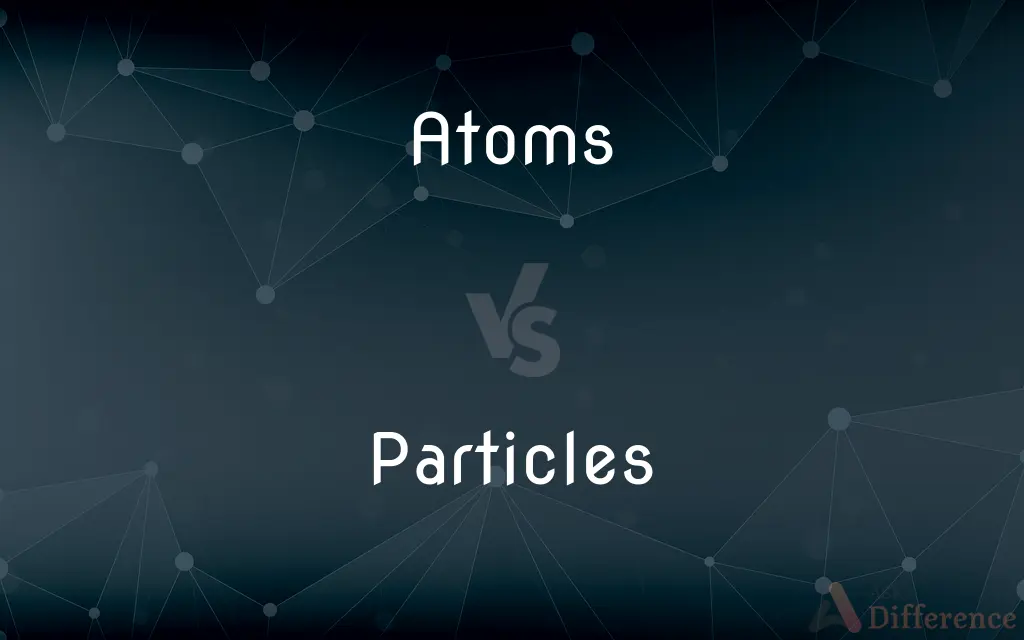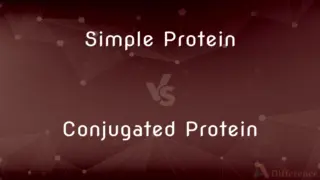Atoms vs. Particles — What's the Difference?
By Tayyaba Rehman — Published on November 4, 2023
Atoms are the basic units of matter, containing protons, neutrons, and electrons, while Particles can be various subatomic entities or compounds, like electrons or dust.

Difference Between Atoms and Particles
Table of Contents
ADVERTISEMENT
Key Differences
Atoms represent the fundamental building blocks of matter, encapsulating protons, neutrons, and electrons in a defined structure. On the other hand, Particles refer broadly to a minute portion of matter, which might be atomic, subatomic, or even compound in nature, lacking the specificity inherent to Atoms.
Every atom carries a nucleus, where protons and neutrons reside, and electrons orbiting around it, which is not necessarily applicable to Particles, as they might not possess a structured nucleus or defined subcomponents, such as in the case of subatomic particles or dust particles.
While Atoms form the base from which molecules and subsequently matter are formed, Particles can be constituents of atoms (like electrons) or larger agglomerates of matter (like dust or sediment particles) thus demonstrating the scope of its ambiguity and range.
Atoms always contain protons, neutrons, and electrons, showcasing a specific structural integrity that is universally recognized. Particles, however, exhibit a vast array of possible compositions, being anything from quarks, neutrinos (subatomic particles) to pollen or pollutants (larger particles).
The stability of Atoms is underscored by principles like the conservation of charge, ensuring the number of protons equals the number of electrons. In contrast, Particles such as ions might exhibit a net electrical charge, displaying the lack of requisite equilibrium that defines atoms.
ADVERTISEMENT
Comparison Chart
Definition
Basic unit of matter.
General term for small bits of matter.
Structural Components
Contains protons, neutrons, and electrons.
May or may not have defined components.
Size
Defined size.
Can be larger or smaller than atoms.
Charge
Typically neutral.
Can be charged or neutral.
Physical Existence
Always matter.
Can be subatomic or larger matter.
Compare with Definitions
Atoms
Atoms contain a nucleus of protons and neutrons.
The Atoms of helium contain two protons in their nucleus.
Particles
Particles can be minute bits of matter, visible or subatomic.
Dust Particles are visible to the naked eye.
Atoms
Atoms can combine to form molecules.
Two hydrogen Atoms combine with one oxygen atom to form water.
Particles
Particles may not always have a defined structure.
Dust Particles vary in shape, size, and composition.
Atoms
Atoms engage in chemical reactions via electron exchanges.
In reactions, Atoms may share or transfer electrons.
Particles
Particles can exist independently or within larger structures.
Smoke consists of myriad tiny Particles.
Atoms
Atoms are neutral entities with equal protons and electrons.
Water is composed of hydrogen and oxygen Atoms.
Particles
A very small piece or part; a tiny portion or speck.
Atoms
Atoms have isotopes varying in neutron number.
Carbon Atoms have isotopes like Carbon-12 and Carbon-14.
Particles
A very small or the smallest possible amount, trace, or degree
Not a particle of doubt.
Atoms
A part or particle considered to be an irreducible constituent of a specified system.
Particles
A body whose spatial extent and internal motion and structure, if any, are irrelevant in a specific problem.
Atoms
The irreducible, indestructible material unit postulated by ancient atomism.
Particles
See elementary particle.
Atoms
An extremely small part, quantity, or amount.
Particles
See subatomic particle.
Atoms
The smallest unit of an element, having all the characteristics of that element and consisting of a very small and dense central nucleus containing protons and neutrons, surrounded by one or more shells of orbiting electrons. Atoms remain undivided in chemical reactions except for the donation, acceptance, or exchange of valence electrons.
Particles
An uninflected item that has grammatical function but does not clearly belong to one of the major parts of speech, such as up in He looked up the word or to in English infinitives.
Atoms
This unit regarded as a source of nuclear energy.
Particles
In some systems of grammatical analysis, any of various short function words, including articles, prepositions, and conjunctions.
Atoms
Plural of atom
Particles
(Ecclesiastical) A portion or fragment of the Eucharistic host.
Particles
(Archaic) A small part of something written, such as a clause of a document.
Particles
Plural of particle
Particles
Particles can carry a charge, like electrons or ions.
Electrons are negatively charged Particles.
Particles
Particles in physics can refer to subatomic entities.
Photons are Particles of light in particle-physics contexts.
Common Curiosities
Can Particles refer to entities smaller than Atoms?
Yes, Particles can refer to subatomic particles, like electrons or quarks, which are smaller than Atoms.
Can Particles be seen with the naked eye?
Some can, like dust or pollen Particles, while subatomic Particles cannot.
What are Atoms composed of?
Atoms are composed of protons, neutrons, and electrons.
Are Atoms always neutral?
Generally, yes, Atoms have equal numbers of protons and electrons, making them neutral.
Can Particles exist in different phases of matter?
Yes, Particles can exist in various phases like solid (dust), liquid (droplets), or gas (airborne particles).
Can Atoms be seen with the naked eye?
No, Atoms are too small to be seen without specialized equipment like scanning tunneling microscopes.
How do Particles behave in scientific experiments?
Particles’ behaviors vary; subatomic particles might be studied in particle accelerators, while larger particles could be observed under microscopes or in colloids.
Do all Atoms of an element have the same number of protons?
Yes, Atoms of a specific element always have the same number of protons.
What are ions in the context of Atoms?
Ions are Atoms that have lost or gained electrons, giving them a net positive or negative charge.
How are Particles related to particle physics?
In particle physics, Particles refer to subatomic entities, like quarks and leptons, which are constituents of atoms or exist independently.
Is there a relationship between Atoms and Particles?
Yes, Atoms are made up of subatomic Particles, such as electrons, protons, and neutrons, while the term “Particles” can also refer to larger entities.
How do Atoms form molecules?
Atoms form molecules by sharing or exchanging electrons to create chemical bonds, like covalent or ionic bonds.
What’s the significance of atomic number?
The atomic number, unique to each element, denotes the number of protons in the nucleus of its Atoms, determining its position in the periodic table.
Can Atoms be broken down further?
Yes, Atoms consist of subatomic particles: protons, neutrons, and electrons, which themselves contain quarks (except electrons).
Can Particles be artificially created?
Yes, Particles can be artificially created, like in laboratories where particle accelerators generate high-energy particles.
Share Your Discovery

Previous Comparison
ABA Number vs. Routing Number
Next Comparison
Simple Protein vs. Conjugated ProteinAuthor Spotlight
Written by
Tayyaba RehmanTayyaba Rehman is a distinguished writer, currently serving as a primary contributor to askdifference.com. As a researcher in semantics and etymology, Tayyaba's passion for the complexity of languages and their distinctions has found a perfect home on the platform. Tayyaba delves into the intricacies of language, distinguishing between commonly confused words and phrases, thereby providing clarity for readers worldwide.













































